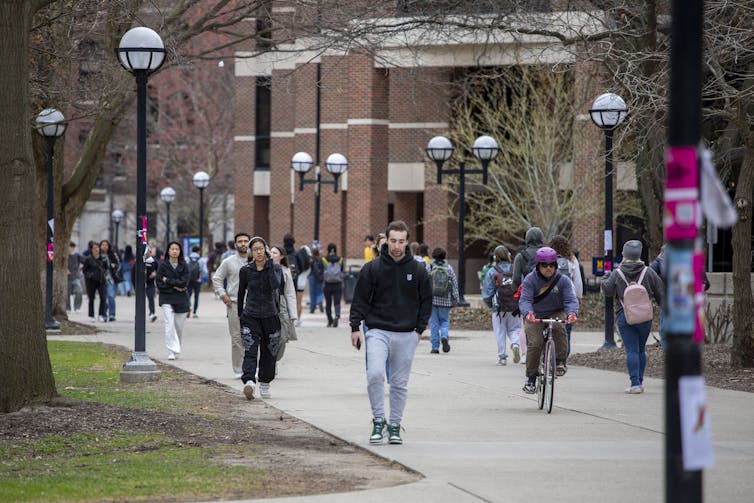Source: The Conversation – Africa (2) – By Roxy Davis, Doctor of philosophy, University of Cape Town
Children with disabilities face significant challenges in South Africa. Firstly there are delayed diagnoses which can lead to complications. The high cost of healthcare and little financial support for their families can limit their access to healthcare services altogether.
There is also little access to rehabilitation services. Inadequate facilities and a shortage of trained personnel are just some of the obstacles.
I started thinking about ways to get over these obstacles when I noticed that people with disabilities weren’t well represented in my sport.
As a competitive surfer and instructor, I had always celebrated the ocean’s ability to inspire confidence and resilience.
Every day, the beach was alive with activity – surfers, families and ocean lovers. Yet among them, I rarely saw people with disabilities in the water.
I began to notice that the beachfront itself, the infrastructure, the culture, and even my own surf school, weren’t actively creating space for inclusivity.
This would eventually become the cornerstone of the Roxy Davis Foundation, established in 2019, and later my doctoral research focusing on ocean-based therapy for children with disabilities.
I found surf therapy enhanced the mental, emotional, and physical well-being of these children.
New therapy
Surf therapy teaches people with disabilities to surf to promote psychological, physical and psychosocial well-being.
The first peer reviewed publication on surf therapy appeared in 2010 and focused on Aboriginal children in Australia. It was about mitigating the inter-generational trauma suffered as a result of the government-sanctioned removal of Aboriginal children from their families, a policy that only ended in the 1970s.
In 2020 a review of a 10-year period included 29 studies into war veterans and young adult cancer survivors, among others.
One such study focused on children with autism spectrum disorder. The study took place in the north-west of Ireland. Children said they felt happier and free, while their parents said they were more relaxed and confident.
A South African study with children with autism spectrum disorder explored the feasibility and unique benefits of an existing surf therapy programme and reported largely positive results.
My own research involved an adapted surf therapy programme for children with a range of disabilities.
Five children aged between 12 and 16 were enrolled. Altogether there were 35 participants including parents, counsellors, volunteers, physiotherapists and surf instructors.
Four of the five children were from under-resourced communities in South Africa’s Western Cape province and all had either a physical, sensory, intellectual or cognitive impairment.
None of the children had taken part in ocean sports before.
Getting into the water
For six weeks the children took part in a three-hour surf therapy session on a Friday afternoon.
The first goal was to get the kids in the water. We used mobility mats, surfboards with handles and amphibious beach wheelchairs to help.
Each child was taught now to surf according to their pace of learning and ability.
There was also a “surfers’ circle” with a discussion topic for each session.
After six weeks we conducted follow-up interviews to see what changes the children had experienced, and if these had any influence on their lives outside surfing.
We also asked parents and counsellors to identify the most significant changes in the children.
‘I felt free and confident’
Final interviews were completed one year later.
Charlie, aged 12, with cerebral palsy: “If my brothers want to go surfing I don’t have to stay behind and just watch them, I can go surf with them. It is so cool to surf with my dad and my brothers.”
Charlie’s teacher: “His self-awareness level and how he sees himself in the world has really improved.”
Tala, aged 15, with cerebal palsy: “Once I started surfing, I felt free and confident. Even in other spaces, when I’m not surfing, like, ‘Yeah I can surf, I can do something like surfing that I didn’t know that I could do before.’ ”
Tala’s school psychologist: “She went into this feeling very insecure, nervous and anxious. She said she will always remember who she was and how she felt before she went to the programme and how she came out of it … to be able to use that feeling and apply it to a different situation, that’s huge for her.”
Princess, aged 15, with spina bifida: was determined to “wean” herself off using nappies after gaining confidence through surf therapy.
Princess’s guardian described her experience as similar to “winning a gold medal … She was more confident in herself than ever. She is off that nappy completely now.”
Thabo, aged 14, a leg amputee: “Before session one, I was feeling nervous and excited, but as soon as I got in the sea, the nerves disappeared. You look and realise you can actually do that. I feel like I belong in the ocean.”
After the final session he said: “I can relax, I can be in control of my urges and my temper. I’m now not always thinking about what people think about me. I can be myself in many ways.”
Rowan, aged 15, a quadruple amputee: “Before I started surfing, I was thinking I can’t do it until I tried it and just being there was like beyond being able to speak in my wildest dreams. I couldn’t believe I could surf in the ocean riding some waves.
“On my first session, I was like ‘If I can do it, I can do it for the rest of my life’.”
In his second interview he said: “My goal is to become a national champion and to become a Paralympic champion.”
One year after the surf therapy programme he entered a provincial parasurfing competition, which he won. He was then selected to participate in the South African Para Surfing Championships in 2022, where he came second. Later that year he was selected to represent South Africa at the World Para Surfing Championships in California. Nineteen months after starting surfing, in December, on his 16th birthday, he competed in the World Championships and was placed 17th.
Surf therapy demonstrates what’s possible when we focus on ability rather than limitation.
![]()
Roxy Davis is affiliated with the Roxy Davis Foundation.
Angus Hunter, Theresa Lorenzo, and Yumna Albertus do not work for, consult, own shares in or receive funding from any company or organisation that would benefit from this article, and have disclosed no relevant affiliations beyond their academic appointment.
– ref. Surf therapy for children with disabilities: how it’s changing lives in South Africa – https://theconversation.com/surf-therapy-for-children-with-disabilities-how-its-changing-lives-in-south-africa-245290



























